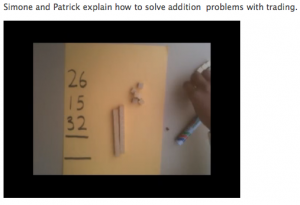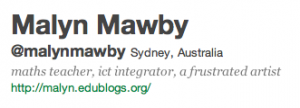Oops, I missed Activity 4 as this is Activity 5 of the Teacher Challenge Blogging with students. Maybe I’ll get back to 4 one day. But as it is, I’ve been mulling over whether or not to do this post as I struggled with inspiration. I think I’ve got my mojo for now so best to let it flow.
Looking at the winners of the 2010 Edublogs Award for class blogs, two things were immediately obvious (1) students contributed and (2) teachers facilitated and moderated (as well as contributed, of course). For this little bit more, I’m honing in on the Blog Dogs – catchy name, yeah?
Student Contributions
 It is not unusual for class blogs to allow students to contribute via blog posts, with or without pictures. In the Blog Dogs (Year 3s at that!), students have videos posted up. The picture on the right is a snapshot of one such video where Simone and Patrick explain and demonstrate addition. Frankly (as a maths teacher), I shudder to think how such an explanation can be done as a text-based post, even with photos.
It is not unusual for class blogs to allow students to contribute via blog posts, with or without pictures. In the Blog Dogs (Year 3s at that!), students have videos posted up. The picture on the right is a snapshot of one such video where Simone and Patrick explain and demonstrate addition. Frankly (as a maths teacher), I shudder to think how such an explanation can be done as a text-based post, even with photos.
I think a multi-modal approach to air student voices encourages creativity as well as provide multiple avenues for expression. Surely that’s a good thing.
Teacher Moderation
Part of moderation is certainly looking at what’s appropriate prior to publishing a post. Even better is to publish the guidelines used for appropriateness. I like that the Blog Dogs have their blogging rules prominently displayed and pitched perfectly (in my opinion, anyway). AND, there are examples…
– Never post your full name or the full name of others – only first names
– Never post any details about where you might live: eg) “Hi I’m Mitch and I live in Smith Street, Smithville” – BAD.
“Hi I’m Mitch and I live in Epping/NSW” – GOOD.
I would probably format the text for ease-of-reading but the content itself is exemplary. I have a very strong hunch that the teacher has gone over the rules with the class plenty of times and modeled application accordingly.
In summary….
For students to successfully engage in class blogs, there are 3 key factors (yes, it’s a list…again…)
- Encourage multi-modal contributions
- Moderate contributions. Give feedback as appropriate, positive and negative
- Have rules and use them
I probably missed other important factors but I reckon if you have the 3 above, you’re well on your way to a successful class blogs (award-winning or not).




